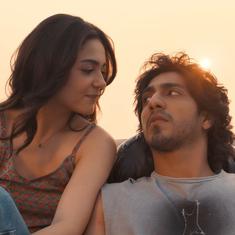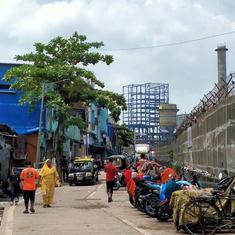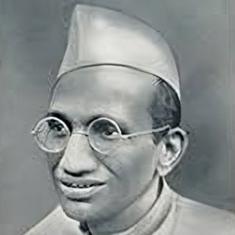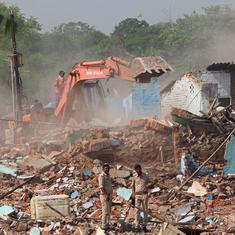Alert: Spoilers ahead about Saiyaara’s plot.
Soon after Saiyaara’s release on July 18, a Mumbai screenwriter joked on Instagram that he had thrown away his horror comedy script and would be pitching a romantic film instead.
Mohit Suri’s musical, starring Aneet Padda and first-time actor Ahaan Pandey, is a box office scorcher, earning reportedly over Rs 83 crore in its opening weekend – a feat for a movie with untested leads.
Saiyaara has broken the myths that nepo-debutants are doomed to fail theatrically – Ahaan Panday is Chunky Panday’s nephew – and that it’s the age of action-based films and Stree-like horror comedies. Saiyaara has confirmed that young audiences still want love stories – but black, without cream and sugar.
Produced by Aditya Chopra’s Yash Raj Films, which is known for its sunny romances, Saiyaara stars Panday as struggling bad-boy rocker Krish. His talent and temper hide his troubled relationship with his alcoholic father. Padda plays poet-writer Vaani, who is nursing a severe heartbreak.
The plot brings them together to work on a song. They fall in love over some crackling tunes. Midway, Vaani is diagnosed with Alzheimer’s. Krish struggles to accept their fate, but remains a dutiful lover.
For industry watchers, Saiyaara’s success is a headscratcher. Does it do anything new? Yes, it does – but also not really.
Writer-director Mohit Suri is a master in packaging disparate elements like Hollywood and Korean neo-noirs, feverish Hallyu-flavoured romance and fresh indie music from the subcontinent. Suri also has his uncle and mentor Mahesh Bhatt’s natural flair for staging dramatic scenes between adult lovers.
Suri’s unique talents, previously seen in Zeher, Awaarapan, Murder 2, Aashiqui 2, Ek Villain and Malang, got burnished with Aditya Chopra’s financial backing in Saiyaara. The result: a long-awaited comeback for the romantic film, albeit in Goth makeup.
The road to Saiyaara is packed with filmmakers – Suri among them – and younger Bollywood stars checking out of traditional romantic dramas through the 2010s.
The fulcrum of the romantic genre is the belief in the institution of marriage. This requires a positive attitude towards heterosexual dating mores – perhaps last seen in Humpty Sharma Ki Dulhania (2014). But that film too was a tribute to Chopra’s Dilwale Dulhania Le Jayenge, the seminal romantic movie for an entire generation. In HSKD’s retread of older tropes without a new vision in sight lay hints of the genre’s decline.
The present and past decades are awash with gloomy love stories with downbeat themes, whether in Hollywood or Bollywood – mental health (Chemical Hearts, Laila Majnu), infidelity (Marriage Story, Gehraiyaan), terminal illness (The Fault in Our Stars, Ae Dil Hai Mushkil) and abuse (It Ends with Us, Satyaprem Ki Katha).
The “chocolate boy” too got bitter. Between the success of Sandeep Reddy Vanga’s Arjun Reddy (2017) and its Bollywood remake Kabir Singh (2019) came the pop culture shift towards tales of dangerous love on BookTok, Bookstagram and Tumblr. Like the men with violent tendencies in young adult literature and fan fiction, Vanga's heroes too don't hesitate to threaten women into having sex.
All this coincided with the global dating app boom of the 2010s. Romantic films began to feature protagonists struggling to choose the right partner out of endless options offered on the e-dating aisle.
The desperation and ennui of this culture made its way to Hollywood films like Newness (2017) and Indian series such as Mismatched and Modern Love. The transformation of the genre is also consistent with the world-wide shift towards hetero-pessimism, coming in the wake of the MeToo movement.
Even Imtiaz Ali, Bollywood’s other consistent chronicler of contemporary romance, began to make his love stories messier. His Tamasha feels less a romance and more a coming-of-age film about a manic-depressive man.
In Hollywood, studios began neglecting mid-budget fare that include rom-coms in favour of tentpole films, such as superhero films, spy thrillers and reliable family-friendly IP. Mid-budget movies have been under threat in India too, with the pan-Indian success of Baahubali (2015-2017) followed by endless imitators.
The southern film industries managed to keep love stories alive, with their directors combining coming-of-age stories with the long-winded messiness of finding and holding on to love. Hemanth M Rao’s two-part Sapta Saagaradaache Ello and the Malayalam superhits Hridayam and Premalu exemplify this trend.
In Bollywood, the romances that left a mark – Manmarziyaan, Gehraiyaan, Haseen Dilruba – either addressed current misgivings about the promise of heterosexual fulfilment or muddled the story with trauma and disease. Notably, they are either streaming releases or theatrical films that have gained traction after becoming available online.
The Bollywood rom-com never did disappear entirely. It hid itself inside the North Indian comedy of manners that doubled up as family films. Examples include the prototype Dum Laga Ke Haisha (2015), Bareilly Ki Barfi (2017), Luka Chhupi (2020) and Zara Bachke Zara Hatke (2023).
But the traditional rom-com, whose engine was the friction between a man and a woman of strong and contrasting personalities, in an urban setting with no family in sight, had all but vanished. Karan Johar did take up the challenge and attempt Rocky Aur Rani Kii Prem Kahaani (2023), bridging the classic rom-com with woke subversions, but it didn’t entirely work.
Mohit Suri, who can thank South Korea for his career, has punctuated Saiyaara with elements from the Hallyu romance A Moment to Remember (2004). Suri’s ever-reliable ear for angsty emo pop has done wonders. Perhaps Mumbai filmmakers will have to grunge up their romantic heroes, trauma-load their heroines and pre-book Mithoon if the romantic drama has to be kept alive after this miraculous comeback.
Also read:










